高考英语传统文化素材作文总结
高考英语作文 范文4篇 中国传统文化
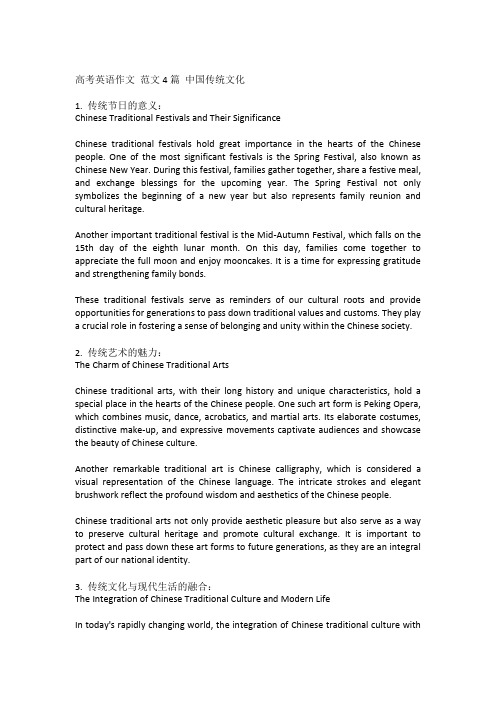
高考英语作文范文4篇中国传统文化1. 传统节日的意义:Chinese Traditional Festivals and Their SignificanceChinese traditional festivals hold great importance in the hearts of the Chinese people. One of the most significant festivals is the Spring Festival, also known as Chinese New Year. During this festival, families gather together, share a festive meal, and exchange blessings for the upcoming year. The Spring Festival not only symbolizes the beginning of a new year but also represents family reunion and cultural heritage.Another important traditional festival is the Mid-Autumn Festival, which falls on the 15th day of the eighth lunar month. On this day, families come together to appreciate the full moon and enjoy mooncakes. It is a time for expressing gratitude and strengthening family bonds.These traditional festivals serve as reminders of our cultural roots and provide opportunities for generations to pass down traditional values and customs. They playa crucial role in fostering a sense of belonging and unity within the Chinese society.2. 传统艺术的魅力:The Charm of Chinese Traditional ArtsChinese traditional arts, with their long history and unique characteristics, hold a special place in the hearts of the Chinese people. One such art form is Peking Opera, which combines music, dance, acrobatics, and martial arts. Its elaborate costumes, distinctive make-up, and expressive movements captivate audiences and showcase the beauty of Chinese culture.Another remarkable traditional art is Chinese calligraphy, which is considered a visual representation of the Chinese language. The intricate strokes and elegant brushwork reflect the profound wisdom and aesthetics of the Chinese people.Chinese traditional arts not only provide aesthetic pleasure but also serve as a way to preserve cultural heritage and promote cultural exchange. It is important to protect and pass down these art forms to future generations, as they are an integral part of our national identity.3. 传统文化与现代生活的融合:The Integration of Chinese Traditional Culture and Modern LifeIn today's rapidly changing world, the integration of Chinese traditional culture withmodern life has become a topic of great significance. As China embraces modernization, it is crucial to strike a balance between preserving our rich cultural heritage and embracing new ideas and technologies.Chinese traditional culture offers valuable wisdom and moral principles that can guide us in navigating the challenges of modern society. Concepts such as filial piety, respect for elders, and harmony have deep roots in our culture and can contribute to building a harmonious and prosperous society.At the same time, traditional culture must adapt to the needs and preferences of modern life. This can be achieved through innovative approaches, such as incorporating traditional elements into contemporary art, fashion, and entertainment. By embracing both tradition and innovation, we can create a vibrant and dynamic society that retains its cultural identity while moving forward.4. 传统道德与现代价值观的冲突与融合:The Conflict and Integration of Traditional Morality and Modern ValuesIn today's rapidly changing world, there is often a clash between traditional morality and modern values. Traditional Chinese morality places emphasis on virtues such as honesty, respect, and filial piety, while modern society often prioritizes individualism, materialism, and personal freedom.The conflict between traditional morality and modern values poses challenges for individuals and society. However, it is important to find a balance and seek integration. Traditional morality provides a moral compass that guides individuals in making ethical decisions and maintaining social harmony. On the other hand, modern values encourage personal growth, diversity, and the pursuit of individual happiness.To achieve a harmonious integration, it is essential to identify the common ground between traditional morality and modern values. Both emphasize the importance of empathy, integrity, and social responsibility. By embracing these shared values, we can bridge the gap between tradition and modernity, creating a society that respects its cultural heritage while adapting to the changing world.。
高中英语 高考英语作文 有关中国传统文化的范文5篇
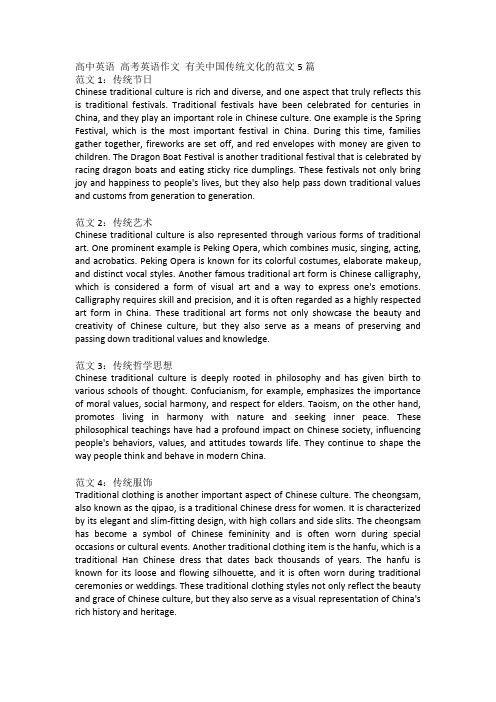
高中英语高考英语作文有关中国传统文化的范文5篇范文1:传统节日Chinese traditional culture is rich and diverse, and one aspect that truly reflects this is traditional festivals. Traditional festivals have been celebrated for centuries in China, and they play an important role in Chinese culture. One example is the Spring Festival, which is the most important festival in China. During this time, families gather together, fireworks are set off, and red envelopes with money are given to children. The Dragon Boat Festival is another traditional festival that is celebrated by racing dragon boats and eating sticky rice dumplings. These festivals not only bring joy and happiness to people's lives, but they also help pass down traditional values and customs from generation to generation.范文2:传统艺术Chinese traditional culture is also represented through various forms of traditional art. One prominent example is Peking Opera, which combines music, singing, acting, and acrobatics. Peking Opera is known for its colorful costumes, elaborate makeup, and distinct vocal styles. Another famous traditional art form is Chinese calligraphy, which is considered a form of visual art and a way to express one's emotions. Calligraphy requires skill and precision, and it is often regarded as a highly respected art form in China. These traditional art forms not only showcase the beauty and creativity of Chinese culture, but they also serve as a means of preserving and passing down traditional values and knowledge.范文3:传统哲学思想Chinese traditional culture is deeply rooted in philosophy and has given birth to various schools of thought. Confucianism, for example, emphasizes the importance of moral values, social harmony, and respect for elders. Taoism, on the other hand, promotes living in harmony with nature and seeking inner peace. These philosophical teachings have had a profound impact on Chinese society, influencing people's behaviors, values, and attitudes towards life. They continue to shape the way people think and behave in modern China.范文4:传统服饰Traditional clothing is another important aspect of Chinese culture. The cheongsam, also known as the qipao, is a traditional Chinese dress for women. It is characterized by its elegant and slim-fitting design, with high collars and side slits. The cheongsam has become a symbol of Chinese femininity and is often worn during special occasions or cultural events. Another traditional clothing item is the hanfu, which is a traditional Han Chinese dress that dates back thousands of years. The hanfu is known for its loose and flowing silhouette, and it is often worn during traditional ceremonies or weddings. These traditional clothing styles not only reflect the beauty and grace of Chinese culture, but they also serve as a visual representation of China's rich history and heritage.范文5:传统医学Traditional Chinese medicine (TCM) is an integral part of Chinese traditional culture. TCM has a history of thousands of years and is based on the principles of balance and harmony within the body. It incorporates various practices, such as acupuncture, herbal medicine, and dietary therapy, to treat and prevent illnesses. TCM takes a holistic approach to health, focusing on the overall well-being of an individual rather than just treating specific symptoms. It has gained recognition worldwide for its effectiveness and natural healing methods. TCM not only provides alternative medical treatments, but it also represents the wisdom, knowledge, and cultural heritage of the Chinese people.These are just a few examples of how Chinese traditional culture is manifested in different aspects of life. From festivals to art, philosophy, clothing, and medicine, Chinese traditional culture continues to thrive and shape the identity of the Chinese people. It is an invaluable treasure that deserves to be celebrated and preserved for generations to come.。
高中英语 高考英语作文有关中国传统文化的范文4篇带中文翻译
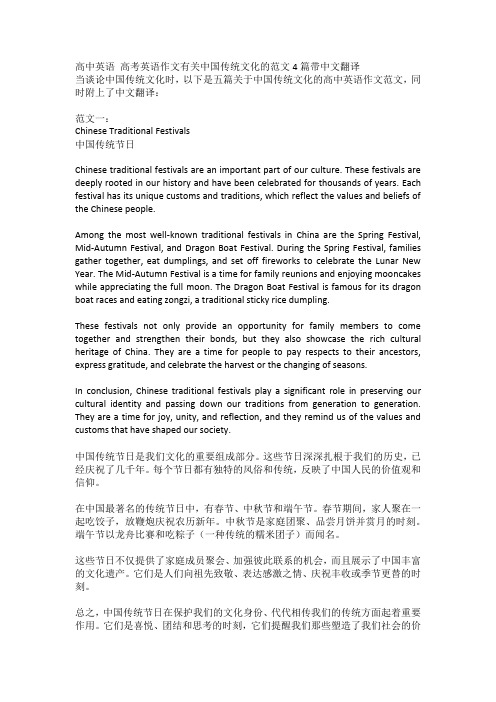
高中英语高考英语作文有关中国传统文化的范文4篇带中文翻译当谈论中国传统文化时,以下是五篇关于中国传统文化的高中英语作文范文,同时附上了中文翻译:范文一:Chinese Traditional Festivals中国传统节日Chinese traditional festivals are an important part of our culture. These festivals are deeply rooted in our history and have been celebrated for thousands of years. Each festival has its unique customs and traditions, which reflect the values and beliefs of the Chinese people.Among the most well-known traditional festivals in China are the Spring Festival, Mid-Autumn Festival, and Dragon Boat Festival. During the Spring Festival, families gather together, eat dumplings, and set off fireworks to celebrate the Lunar New Year. The Mid-Autumn Festival is a time for family reunions and enjoying mooncakes while appreciating the full moon. The Dragon Boat Festival is famous for its dragon boat races and eating zongzi, a traditional sticky rice dumpling.These festivals not only provide an opportunity for family members to come together and strengthen their bonds, but they also showcase the rich cultural heritage of China. They are a time for people to pay respects to their ancestors, express gratitude, and celebrate the harvest or the changing of seasons.In conclusion, Chinese traditional festivals play a significant role in preserving our cultural identity and passing down our traditions from generation to generation. They are a time for joy, unity, and reflection, and they remind us of the values and customs that have shaped our society.中国传统节日是我们文化的重要组成部分。
高考英语作文范文5篇 中国传统文化
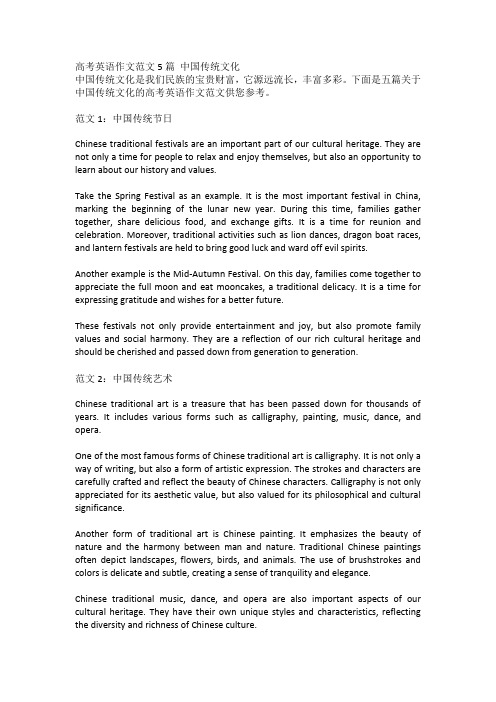
高考英语作文范文5篇中国传统文化中国传统文化是我们民族的宝贵财富,它源远流长,丰富多彩。
下面是五篇关于中国传统文化的高考英语作文范文供您参考。
范文1:中国传统节日Chinese traditional festivals are an important part of our cultural heritage. They are not only a time for people to relax and enjoy themselves, but also an opportunity to learn about our history and values.Take the Spring Festival as an example. It is the most important festival in China, marking the beginning of the lunar new year. During this time, families gather together, share delicious food, and exchange gifts. It is a time for reunion and celebration. Moreover, traditional activities such as lion dances, dragon boat races, and lantern festivals are held to bring good luck and ward off evil spirits.Another example is the Mid-Autumn Festival. On this day, families come together to appreciate the full moon and eat mooncakes, a traditional delicacy. It is a time for expressing gratitude and wishes for a better future.These festivals not only provide entertainment and joy, but also promote family values and social harmony. They are a reflection of our rich cultural heritage and should be cherished and passed down from generation to generation.范文2:中国传统艺术Chinese traditional art is a treasure that has been passed down for thousands of years. It includes various forms such as calligraphy, painting, music, dance, and opera.One of the most famous forms of Chinese traditional art is calligraphy. It is not only a way of writing, but also a form of artistic expression. The strokes and characters are carefully crafted and reflect the beauty of Chinese characters. Calligraphy is not only appreciated for its aesthetic value, but also valued for its philosophical and cultural significance.Another form of traditional art is Chinese painting. It emphasizes the beauty of nature and the harmony between man and nature. Traditional Chinese paintings often depict landscapes, flowers, birds, and animals. The use of brushstrokes and colors is delicate and subtle, creating a sense of tranquility and elegance.Chinese traditional music, dance, and opera are also important aspects of our cultural heritage. They have their own unique styles and characteristics, reflecting the diversity and richness of Chinese culture.Overall, Chinese traditional art is a reflection of our history, philosophy, and values. It is important to preserve and promote these art forms, as they play a significant role in shaping our national identity.范文3:中国传统节庆习俗Chinese traditional festivals are not only about celebration, but also about the customs and traditions that have been passed down for generations. These customs and traditions are an important part of our cultural heritage.For example, during the Spring Festival, people decorate their homes with red lanterns and couplets. They also set off firecrackers to drive away evil spirits and bring good luck. Another custom is the giving of red envelopes, which contain money, as a symbol of good fortune.During the Mid-Autumn Festival, people gather with their families to appreciate the full moon and eat mooncakes. Children also carry brightly lit lanterns and participate in lantern parades.Dragon boat races are a popular tradition during the Dragon Boat Festival. People race dragon boats and eat zongzi, a traditional rice dumpling wrapped in bamboo leaves, to commemorate the poet Qu Yuan.These customs and traditions not only add joy and excitement to the festivals, but also serve as a way to pass down our cultural values and beliefs. They are a reminder of our history and the importance of family and community.范文4:中国传统文化的智慧Chinese traditional culture is not only about customs and traditions, but also contains profound wisdom and philosophy. It has been a source of guidance and inspiration for generations.One example is the concept of Yin and Yang. This philosophy emphasizes the balance and harmony between opposing forces. It teaches us that everything in the world has its opposite and that they are interconnected and interdependent. This concept can be applied to various aspects of life, such as health, relationships, and decision-making.Another example is Confucianism, which emphasizes the importance of moral values, filial piety, and social harmony. Confucian teachings have had a significant impact on Chinese society and have shaped the values and behavior of the Chinese people.Chinese traditional culture also values the importance of education. The saying "learning is like rowing upstream, not to advance is to fall back" reflects the belief that continuous learning and self-improvement are essential for personal and societal development.These are just a few examples of the wisdom and philosophy embedded in Chinese traditional culture. They continue to resonate with people today and provide valuable insights for navigating the complexities of modern life.范文5:传统与现代的融合In today's rapidly changing world, it is important to find a balance between tradition and modernity. Chinese traditional culture has a rich history and deep roots, but it also needs to adapt and evolve with the times.One example of the fusion of tradition and modernity is Chinese traditional medicine. It has a history of thousands of years and is based on the principles of balance and harmony. Traditional Chinese medicine has been able to integrate modern scientific research and technology, making it more effective and accessible to people around the world.Another example is traditional Chinese architecture. Traditional Chinese buildings are known for their unique style and exquisite craftsmanship. However, modern architects have found ways to incorporate traditional elements into contemporary designs, creating a harmonious blend of old and new.Furthermore, traditional Chinese arts and crafts, such as pottery, paper cutting, and embroidery, have also undergone modern transformations. Artists and designers have found innovative ways to reinterpret these traditional art forms, making them more relevant and appealing to younger generations.The fusion of tradition and modernity not only preserves our cultural heritage, but also allows it to remain vibrant and relevant in today's society. It is a testament to the resilience and adaptability of Chinese traditional culture.。
高考英语作文 范文5篇 中国传统文化

高考英语作文范文5篇中国传统文化1. 保护传统文化的重要性China's traditional culture plays a vital role in our nation's identity and heritage. It is our responsibility to protect and preserve it. Firstly, traditional culture embodies our values, ethics, and wisdom, providing guidance for present and future generations. Secondly, it fosters a sense of pride and belonging, enhancing national unity. Lastly, traditional culture is a valuable resource for tourism, attracting visitors from all over the world. Therefore, it is crucial to make efforts to protect and promote our traditional culture.2. 传统文化的应用与创新Traditional culture is not only a historical relic, but also a source of inspiration for contemporary society. By applying and innovating traditional cultural elements, we can create unique and modern achievements. For instance, traditional Chinese medicine, with its holistic approach to health, has gained recognition worldwide. Additionally, traditional arts like calligraphy and painting have been integrated into modern design and fashion. Embracing the essence of our traditional culture while adapting to the needs of the times can lead to remarkable results.3. 传统节日的意义与庆祝方式Traditional festivals in China hold great significance and are celebrated in various ways. Take the Spring Festival as an example. It not only marks the beginning of the lunar year, but also represents family reunion and the hopes for a prosperous year ahead. People celebrate by setting off fireworks, sharing festive meals, and exchanging red envelopes. These traditions not only bring joy and blessings, but also strengthen family bonds and cultural cohesion. It is important to cherish and continue these meaningful celebrations.4. 文化遗产保护与传承China boasts a rich cultural heritage that needs to be protected and passed down to future generations. Efforts should be made to preserve cultural relics, such as ancient buildings, artifacts, and traditional craftsmanship. Furthermore, promoting cultural education in schools and communities can help raise awareness and appreciation for our heritage. Through these measures, we can ensure that our cultural legacy remains alive and thriving.5. 传统文化的国际传播The international dissemination of traditional culture is of great significance in promoting cultural exchanges and enhancing mutual understanding among nations. Confucius Institutes, for example, have been established worldwide to teach Chinese language and culture. Traditional Chinese performing arts, such as Peking Opera and traditional music, are also showcased on international stages, attracting audiences from diverse backgrounds. By sharing our traditional culture with the world, we can build bridges of friendship and create a harmonious global community.。
高三英语作文传统文化(精选18篇)
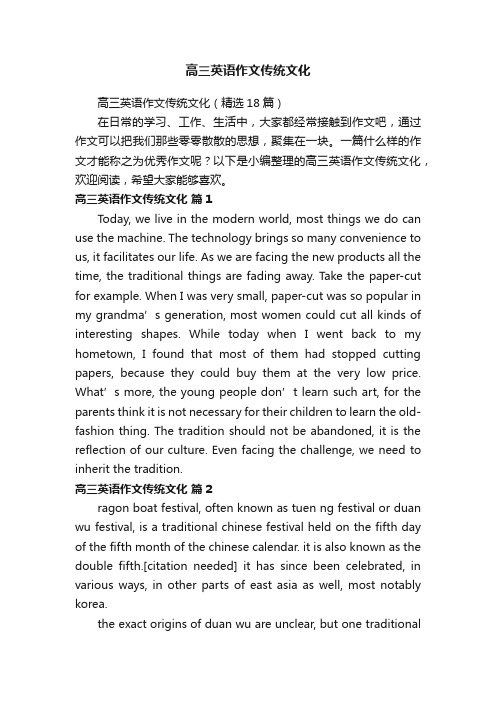
高三英语作文传统文化高三英语作文传统文化(精选18篇)在日常的学习、工作、生活中,大家都经常接触到作文吧,通过作文可以把我们那些零零散散的思想,聚集在一块。
一篇什么样的作文才能称之为优秀作文呢?以下是小编整理的高三英语作文传统文化,欢迎阅读,希望大家能够喜欢。
高三英语作文传统文化篇1Today, we live in the modern world, most things we do can use the machine. The technology brings so many convenience to us, it facilitates our life. As we are facing the new products all the time, the traditional things are fading away. Take the paper-cut for example. When I was very small, paper-cut was so popular in my grandma’s generation, most women could cut all kinds of interesting shapes. While today when I went back to my hometown, I found that most of them had stopped cutting papers, because they could buy them at the very low price. What’s more, the young people don’t learn such art, for the parents think it is not necessary for their children to learn the old-fashion thing. The tradition should not be abandoned, it is the reflection of our culture. Even facing the challenge, we need to inherit the tradition.高三英语作文传统文化篇2ragon boat festival, often known as tuen ng festival or duan wu festival, is a traditional chinese festival held on the fifth day of the fifth month of the chinese calendar. it is also known as the double fifth.[citation needed] it has since been celebrated, in various ways, in other parts of east asia as well, most notably korea.the exact origins of duan wu are unclear, but one traditionalview holds that the festival memorializes the chinese poet qu yuan of the warring states period. he committed uicide by drowning himself in a river because he was disgusted by the corruption of the chu government. the local people, knowing him to be a good man, decided to throw food into the river to feed the fishes to prevent them from eating qu's body. they also sat on dragon boats, and tried to scare the fishes away by the thundering sound of drums aboard the boat and the fierce looking dragon-head in the front of the boat.in the early years of the chinese republic, duan wu was also celebrated as "poets' day", due to qu yuan's status as china's first poet of personal renown.today, people eat zongzi (the food originally intended to feed the fishes) and race dragon boats in memory of qu's dramatic death.高三英语作文传统文化篇3Today, we live in the modern world, most things we do can use the machine. The technology brings so many convenience to us, it facilitates our life. As we are facing the new products all the time, the traditional things are fading away. Take the paper-cut for example. When I was very small, paper-cut was so popular in my grandma’s generation, most women could cut all kinds of interesting shapes.While today when I went back to my hometown, I found that most of them had stopped cutting papers, because they could buy them at the very low price.What’s more, the young people don’t learn such art, for the parents think it is not necessary for their children to learn the old-fashion thing. The tradition should not be abandoned, it is the reflection of our culture. Even facing the challenge, we needto inherit the tradition.今天,我们生活在摩登时代,我们可以使用机器做大部分的事情。
高考英语作文 范文5篇 中国传统文化
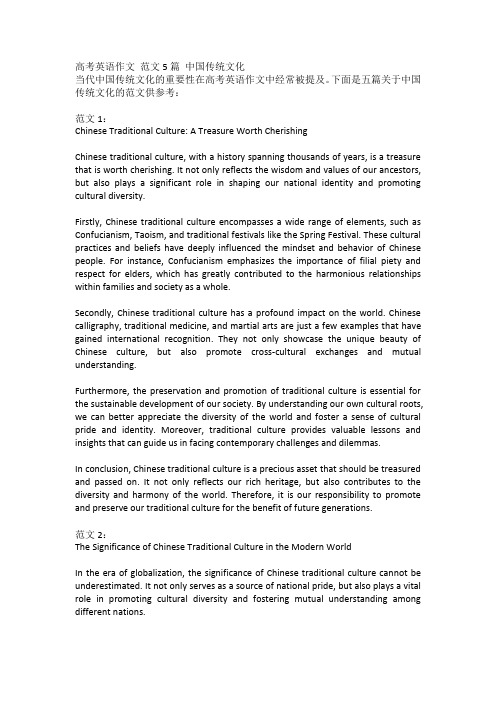
高考英语作文范文5篇中国传统文化当代中国传统文化的重要性在高考英语作文中经常被提及。
下面是五篇关于中国传统文化的范文供参考:范文1:Chinese Traditional Culture: A Treasure Worth CherishingChinese traditional culture, with a history spanning thousands of years, is a treasure that is worth cherishing. It not only reflects the wisdom and values of our ancestors, but also plays a significant role in shaping our national identity and promoting cultural diversity.Firstly, Chinese traditional culture encompasses a wide range of elements, such as Confucianism, Taoism, and traditional festivals like the Spring Festival. These cultural practices and beliefs have deeply influenced the mindset and behavior of Chinese people. For instance, Confucianism emphasizes the importance of filial piety and respect for elders, which has greatly contributed to the harmonious relationships within families and society as a whole.Secondly, Chinese traditional culture has a profound impact on the world. Chinese calligraphy, traditional medicine, and martial arts are just a few examples that have gained international recognition. They not only showcase the unique beauty of Chinese culture, but also promote cross-cultural exchanges and mutual understanding.Furthermore, the preservation and promotion of traditional culture is essential for the sustainable development of our society. By understanding our own cultural roots, we can better appreciate the diversity of the world and foster a sense of cultural pride and identity. Moreover, traditional culture provides valuable lessons and insights that can guide us in facing contemporary challenges and dilemmas.In conclusion, Chinese traditional culture is a precious asset that should be treasured and passed on. It not only reflects our rich heritage, but also contributes to the diversity and harmony of the world. Therefore, it is our responsibility to promote and preserve our traditional culture for the benefit of future generations.范文2:The Significance of Chinese Traditional Culture in the Modern WorldIn the era of globalization, the significance of Chinese traditional culture cannot be underestimated. It not only serves as a source of national pride, but also plays a vital role in promoting cultural diversity and fostering mutual understanding among different nations.Firstly, Chinese traditional culture is a reflection of the wisdom and values accumulated over thousands of years. It offers a unique perspective on life, morality, and social harmony, which can provide guidance and inspiration for people in the modern world. For example, the teachings of Confucianism, such as the importance of benevolence and righteousness, can still be applied to address contemporary social issues and promote ethical values.Secondly, Chinese traditional culture has great potential to contribute to the world. Traditional Chinese medicine, for instance, has gained global recognition for its effectiveness and holistic approach to health. Chinese calligraphy, painting, and cuisine are also highly appreciated for their artistic value and cultural significance. By sharing these cultural treasures, China can enhance cultural exchanges and mutual learning with other nations.Furthermore, Chinese traditional culture serves as a bridge between the past and the future. By understanding and embracing our cultural heritage, we can build a sense of cultural identity and pride, which in turn strengthens our national cohesion. This is particularly important in an era of rapid social change, where cultural values and traditions are easily overlooked or forgotten.In conclusion, Chinese traditional culture holds immense value in the modern world. Its wisdom, beauty, and diversity contribute to the richness of human civilization. Therefore, it is crucial for us to preserve and promote our traditional culture, both for our own benefit and for the betterment of the world.范文3:Preserving and Promoting Chinese Traditional CultureThe preservation and promotion of Chinese traditional culture is of great importance in today's society. It not only helps to maintain our cultural heritage, but also enriches our lives and promotes cultural diversity.Firstly, preserving Chinese traditional culture is crucial for maintaining our cultural identity. Traditional customs, festivals, and rituals are an integral part of our heritage and provide a sense of belonging and continuity. By passing down these traditions to future generations, we ensure that our cultural values and beliefs are not lost.Secondly, promoting Chinese traditional culture contributes to the enrichment of our lives. Traditional arts, such as Chinese painting, calligraphy, and music, are not only aesthetically pleasing, but also provide a means of self-expression and spiritual fulfillment. By encouraging the appreciation and practice of these art forms, we can enhance our cultural literacy and lead more fulfilling lives.Furthermore, Chinese traditional culture promotes cultural diversity and mutualunderstanding. As a nation with a long history and rich cultural traditions, China has much to offer to the world. By sharing our cultural practices and values, we can foster cross-cultural exchanges and promote mutual respect and understanding among different nations.In conclusion, the preservation and promotion of Chinese traditional culture is essential for maintaining our cultural identity, enriching our lives, and promoting cultural diversity. It is our responsibility to pass down our cultural heritage to future generations and to share the beauty and wisdom of Chinese traditional culture with the world.范文4:The Role of Chinese Traditional Culture in Modern EducationChinese traditional culture plays a significant role in modern education. It provides a valuable source of knowledge, wisdom, and moral values that can help cultivate well-rounded individuals and promote social harmony.Firstly, Chinese traditional culture offers a wealth of knowledge that can contribute to a comprehensive education. The classics of Chinese literature, such as "The Analects of Confucius" and "Dream of the Red Chamber," are not only literary masterpieces, but also contain profound insights into human nature, society, and ethics. By studying these works, students can broaden their horizons and develop a deeper understanding of the world.Secondly, Chinese traditional culture emphasizes moral values and virtues. Confucianism, for example, emphasizes the importance of filial piety, respect for elders, and the cultivation of one's moral character. These teachings provide a moral compass for students, guiding them in their personal development and interactions with others.Furthermore, Chinese traditional culture promotes social harmony and cultural diversity. By studying and appreciating different cultural traditions, students can develop a respect for cultural differences and learn to embrace diversity. This is crucial in a multicultural society, where understanding and tolerance are essential for peaceful coexistence.In conclusion, Chinese traditional culture plays a crucial role in modern education. It provides valuable knowledge, moral guidance, and promotes social harmony. Therefore, it is essential for our education system to integrate Chinese traditional culture into the curriculum, ensuring that future generations are equipped with a comprehensive understanding of our cultural heritage.范文5:Revitalizing Chinese Traditional Culture in the Modern EraIn the face of rapid social change and globalization, revitalizing Chinese traditional culture has become an urgent task. By embracing our cultural heritage and adapting it to the modern era, we can ensure the preservation and continued relevance of our traditional culture.Firstly, revitalizing Chinese traditional culture involves promoting cultural awareness and appreciation. This can be achieved through education, cultural events, and community programs. By increasing the exposure and understanding of traditional cultural practices, we can foster a sense of pride and ownership among the younger generation.Secondly, revitalizing Chinese traditional culture requires adapting it to the needs and interests of the modern era. This can be done through innovative approaches that combine traditional elements with contemporary technology and trends. For example, traditional musical instruments can be incorporated into modern compositions, and traditional crafts can be reimagined with modern designs.Furthermore, revitalizing Chinese traditional culture involves engaging with the global community. By sharing our cultural practices and traditions with people from different backgrounds, we can promote cross-cultural understanding and appreciation. This can be achieved through cultural exchanges, international festivals, and online platforms that facilitate cultural exchange.In conclusion, revitalizing Chinese traditional culture is a multifaceted task that requires efforts from individuals, communities, and the society as a whole. By embracing our cultural heritage, adapting it to the modern era, and engaging with the global community, we can ensure the preservation and continued relevance of our traditional culture.。
高考英语作文范文5篇 中国传统文化
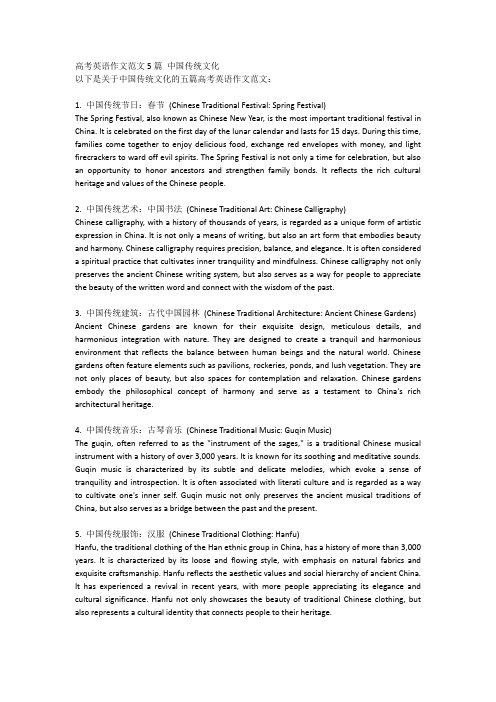
高考英语作文范文5篇中国传统文化以下是关于中国传统文化的五篇高考英语作文范文:1. 中国传统节日:春节(Chinese Traditional Festival: Spring Festival)The Spring Festival, also known as Chinese New Year, is the most important traditional festival in China. It is celebrated on the first day of the lunar calendar and lasts for 15 days. During this time, families come together to enjoy delicious food, exchange red envelopes with money, and light firecrackers to ward off evil spirits. The Spring Festival is not only a time for celebration, but also an opportunity to honor ancestors and strengthen family bonds. It reflects the rich cultural heritage and values of the Chinese people.2. 中国传统艺术:中国书法(Chinese Traditional Art: Chinese Calligraphy)Chinese calligraphy, with a history of thousands of years, is regarded as a unique form of artistic expression in China. It is not only a means of writing, but also an art form that embodies beauty and harmony. Chinese calligraphy requires precision, balance, and elegance. It is often considered a spiritual practice that cultivates inner tranquility and mindfulness. Chinese calligraphy not only preserves the ancient Chinese writing system, but also serves as a way for people to appreciate the beauty of the written word and connect with the wisdom of the past.3. 中国传统建筑:古代中国园林(Chinese Traditional Architecture: Ancient Chinese Gardens) Ancient Chinese gardens are known for their exquisite design, meticulous details, and harmonious integration with nature. They are designed to create a tranquil and harmonious environment that reflects the balance between human beings and the natural world. Chinese gardens often feature elements such as pavilions, rockeries, ponds, and lush vegetation. They are not only places of beauty, but also spaces for contemplation and relaxation. Chinese gardens embody the philosophical concept of harmony and serve as a testament to China's rich architectural heritage.4. 中国传统音乐:古琴音乐(Chinese Traditional Music: Guqin Music)The guqin, often referred to as the "instrument of the sages," is a traditional Chinese musical instrument with a history of over 3,000 years. It is known for its soothing and meditative sounds. Guqin music is characterized by its subtle and delicate melodies, which evoke a sense of tranquility and introspection. It is often associated with literati culture and is regarded as a way to cultivate one's inner self. Guqin music not only preserves the ancient musical traditions of China, but also serves as a bridge between the past and the present.5. 中国传统服饰:汉服(Chinese Traditional Clothing: Hanfu)Hanfu, the traditional clothing of the Han ethnic group in China, has a history of more than 3,000 years. It is characterized by its loose and flowing style, with emphasis on natural fabrics and exquisite craftsmanship. Hanfu reflects the aesthetic values and social hierarchy of ancient China. It has experienced a revival in recent years, with more people appreciating its elegance and cultural significance. Hanfu not only showcases the beauty of traditional Chinese clothing, but also represents a cultural identity that connects people to their heritage.以上是关于中国传统文化的五篇高考英语作文范文,希望对你有所帮助。
高考英语作文范文5篇 中国传统文化
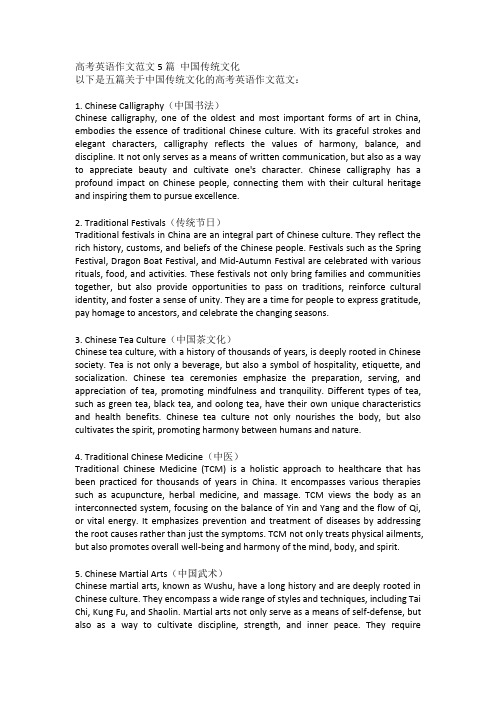
高考英语作文范文5篇中国传统文化以下是五篇关于中国传统文化的高考英语作文范文:1. Chinese Calligraphy(中国书法)Chinese calligraphy, one of the oldest and most important forms of art in China, embodies the essence of traditional Chinese culture. With its graceful strokes and elegant characters, calligraphy reflects the values of harmony, balance, and discipline. It not only serves as a means of written communication, but also as a way to appreciate beauty and cultivate one's character. Chinese calligraphy has a profound impact on Chinese people, connecting them with their cultural heritage and inspiring them to pursue excellence.2. Traditional Festivals(传统节日)Traditional festivals in China are an integral part of Chinese culture. They reflect the rich history, customs, and beliefs of the Chinese people. Festivals such as the Spring Festival, Dragon Boat Festival, and Mid-Autumn Festival are celebrated with various rituals, food, and activities. These festivals not only bring families and communities together, but also provide opportunities to pass on traditions, reinforce cultural identity, and foster a sense of unity. They are a time for people to express gratitude, pay homage to ancestors, and celebrate the changing seasons.3. Chinese Tea Culture(中国茶文化)Chinese tea culture, with a history of thousands of years, is deeply rooted in Chinese society. Tea is not only a beverage, but also a symbol of hospitality, etiquette, and socialization. Chinese tea ceremonies emphasize the preparation, serving, and appreciation of tea, promoting mindfulness and tranquility. Different types of tea, such as green tea, black tea, and oolong tea, have their own unique characteristics and health benefits. Chinese tea culture not only nourishes the body, but also cultivates the spirit, promoting harmony between humans and nature.4. Traditional Chinese Medicine(中医)Traditional Chinese Medicine (TCM) is a holistic approach to healthcare that has been practiced for thousands of years in China. It encompasses various therapies such as acupuncture, herbal medicine, and massage. TCM views the body as an interconnected system, focusing on the balance of Yin and Yang and the flow of Qi, or vital energy. It emphasizes prevention and treatment of diseases by addressing the root causes rather than just the symptoms. TCM not only treats physical ailments, but also promotes overall well-being and harmony of the mind, body, and spirit.5. Chinese Martial Arts(中国武术)Chinese martial arts, known as Wushu, have a long history and are deeply rooted in Chinese culture. They encompass a wide range of styles and techniques, including Tai Chi, Kung Fu, and Shaolin. Martial arts not only serve as a means of self-defense, but also as a way to cultivate discipline, strength, and inner peace. They requirededication, perseverance, and respect for both oneself and others. Chinese martial arts are not just physical exercises, but also a way of life that promotes self-improvement, self-discipline, and the pursuit of balance and harmony.希望以上范文能为您提供一些参考,祝您取得好成绩!。
高中英语 高考英语作文有关中国传统文化的范文5篇带中文翻译
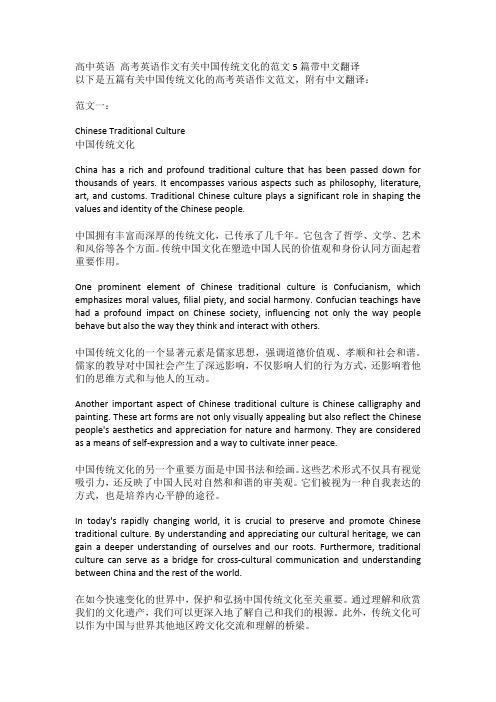
高中英语高考英语作文有关中国传统文化的范文5篇带中文翻译以下是五篇有关中国传统文化的高考英语作文范文,附有中文翻译:范文一:Chinese Traditional Culture中国传统文化China has a rich and profound traditional culture that has been passed down for thousands of years. It encompasses various aspects such as philosophy, literature, art, and customs. Traditional Chinese culture plays a significant role in shaping the values and identity of the Chinese people.中国拥有丰富而深厚的传统文化,已传承了几千年。
它包含了哲学、文学、艺术和风俗等各个方面。
传统中国文化在塑造中国人民的价值观和身份认同方面起着重要作用。
One prominent element of Chinese traditional culture is Confucianism, which emphasizes moral values, filial piety, and social harmony. Confucian teachings have had a profound impact on Chinese society, influencing not only the way people behave but also the way they think and interact with others.中国传统文化的一个显著元素是儒家思想,强调道德价值观、孝顺和社会和谐。
儒家的教导对中国社会产生了深远影响,不仅影响人们的行为方式,还影响着他们的思维方式和与他人的互动。
高中高考英语作文范文5篇 中国传统文化

高中高考英语作文范文5篇中国传统文化以下是五篇关于中国传统文化的高中高考英语作文范文:1. 中国传统节日- 春节(Chinese Traditional Festival - Spring Festival)The Spring Festival, also known as Chinese New Year, is the most important traditional festival in China. It is celebrated on the first day of the lunar calendar and lasts for 15 days. During this time, people engage in various activities to welcome the new year and pray for good fortune.Firstly, people thoroughly clean their houses to remove any bad luck from the previous year. Then, they decorate their homes with red lanterns and paper cuttings, which symbolize happiness and good luck. Family members gather for a reunion dinner, enjoying delicious traditional food and exchanging gifts.Fireworks and firecrackers are set off to scare away evil spirits. The streets are filled with lion and dragon dances, as well as traditional performances like the Beijing Opera. Red envelopes containing money are given to children and unmarried adults as a symbol of good luck.The Spring Festival is not only a time for celebration but also an opportunity to honor ancestors and show respect to elders. It highlights the importance of family unity and traditional values in Chinese culture.2. 中国传统艺术- 京剧(Chinese Traditional Art - Peking Opera)Peking Opera, also known as Beijing Opera, is a traditional form of Chinese theater that combines music, singing, dialogue, and acrobatics. It originated in the late 18th century and has since become one of China's most iconic art forms.Peking Opera is characterized by its elaborate costumes, colorful makeup, and unique vocal techniques. Performers use exaggerated gestures and movements to convey emotions and tell stories. The repertoire includes historical dramas, mythological tales, and literary adaptations.The art of Peking Opera requires years of dedicated training. Performers learn to sing in a distinct style and master various skills, such as martial arts and acrobatics. The music is accompanied by traditional instruments like the erhu and the pipa, creating a harmonious blend of sound and visuals.Peking Opera is not only a form of entertainment but also an important cultural heritage. It reflects the rich history and values of Chinese society, promoting traditional virtues such as loyalty, bravery, and filial piety. It continues to captivate audiences both in China and around the world.3. 中国传统建筑- 故宫(Chinese Traditional Architecture - The Forbidden City)The Forbidden City, also known as the Palace Museum, is a magnificent architectural masterpiece located in the heart of Beijing. It served as the imperial palace during the Ming and Qing dynasties, housing emperors and their households for nearly 500 years.The Forbidden City is a symbol of China's rich cultural heritage and architectural prowess. It covers a vast area with over 9,000 rooms, featuring exquisite designs and intricate details. The complex is surrounded by high walls and a moat, emphasizing its grandeur and providing a sense of security.The architecture of the Forbidden City follows traditional Chinese principles of balance and harmony. The buildings are arranged symmetrically along a central axis, with the Hall of Supreme Harmony as the main ceremonial hall. The roofs are adorned with colorful glazed tiles, representing the imperial status.Visiting the Forbidden City is like stepping back in time and experiencing the grandeur of ancient China. It offers a glimpse into the lives of emperors and their courts, as well as the cultural and artistic achievements of the time. It is a UNESCO World Heritage Site and a testament to China's architectural brilliance.4. 中国传统饮食- 中餐(Chinese Traditional Cuisine)Chinese cuisine, also known as Chinese food, is one of the most diverse and popular cuisines in the world. It is characterized by its rich flavors, varied cooking techniques, and emphasis on fresh ingredients.Chinese cuisine can be divided into eight major regional cuisines, each with its own distinctive style and flavors. Some famous examples include Sichuan cuisine, known for its bold and spicy flavors, and Cantonese cuisine, renowned for its delicate and fresh ingredients.Traditional Chinese dishes often feature a combination of meat, vegetables, and grains. They are cooked using various methods, such as stir-frying, steaming, and braising. Popular ingredients include rice, noodles, soy sauce, garlic, and ginger.In addition to its delicious taste, Chinese cuisine also embodies cultural values and customs. It promotes the concept of balance and harmony, as seen in the use of Yin and Yang principles in food preparation. The tradition of sharing meals with family and friends reinforces the importance of togetherness and hospitality.5. 中国传统医学- 中医(Chinese Traditional Medicine)Traditional Chinese Medicine (TCM) is a holistic approach to healthcare that has been practiced for thousands of years. It encompasses various therapies, including herbal medicine, acupuncture, massage, and dietary therapy.TCM is based on the concept of Qi (vital energy) and the balance of Yin and Yang. It views the body as an interconnected system, where imbalances or blockages can lead to illness. TCM aims to restore harmony and promote overall well-being.Herbal medicine is a fundamental component of TCM. It involves the use of natural substances, such as plants, roots, and minerals, to treat ailments and strengthen the body. Acupuncture, on the other hand, involves the insertion of thin needles into specific points on the body to stimulate energy flow.TCM has gained recognition worldwide for its effectiveness and holistic approach to health. It not only focuses on treating symptoms but also addresses the root causes of diseases. TCM offers a natural and balanced way of maintaining health and preventing illness.以上是五篇关于中国传统文化的高中高考英语作文范文,希望对你有所帮助。
高考英语作文 范文4篇 中国传统文化
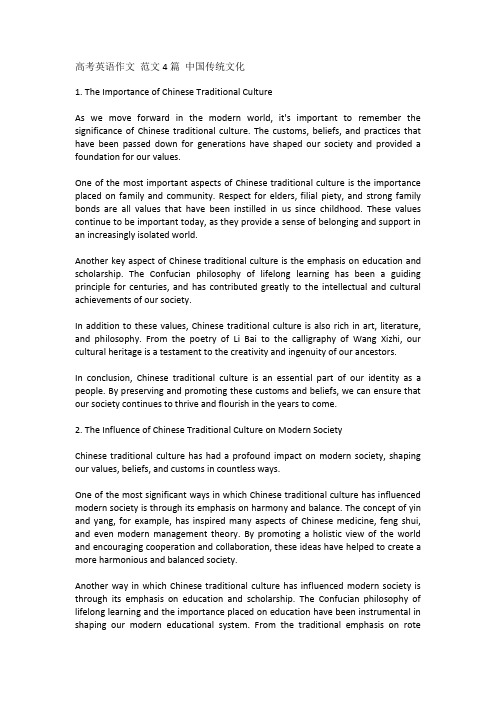
高考英语作文范文4篇中国传统文化1. The Importance of Chinese Traditional CultureAs we move forward in the modern world, it's important to remember the significance of Chinese traditional culture. The customs, beliefs, and practices that have been passed down for generations have shaped our society and provided a foundation for our values.One of the most important aspects of Chinese traditional culture is the importance placed on family and community. Respect for elders, filial piety, and strong family bonds are all values that have been instilled in us since childhood. These values continue to be important today, as they provide a sense of belonging and support in an increasingly isolated world.Another key aspect of Chinese traditional culture is the emphasis on education and scholarship. The Confucian philosophy of lifelong learning has been a guiding principle for centuries, and has contributed greatly to the intellectual and cultural achievements of our society.In addition to these values, Chinese traditional culture is also rich in art, literature, and philosophy. From the poetry of Li Bai to the calligraphy of Wang Xizhi, our cultural heritage is a testament to the creativity and ingenuity of our ancestors.In conclusion, Chinese traditional culture is an essential part of our identity as a people. By preserving and promoting these customs and beliefs, we can ensure that our society continues to thrive and flourish in the years to come.2. The Influence of Chinese Traditional Culture on Modern SocietyChinese traditional culture has had a profound impact on modern society, shaping our values, beliefs, and customs in countless ways.One of the most significant ways in which Chinese traditional culture has influenced modern society is through its emphasis on harmony and balance. The concept of yin and yang, for example, has inspired many aspects of Chinese medicine, feng shui, and even modern management theory. By promoting a holistic view of the world and encouraging cooperation and collaboration, these ideas have helped to create a more harmonious and balanced society.Another way in which Chinese traditional culture has influenced modern society is through its emphasis on education and scholarship. The Confucian philosophy of lifelong learning and the importance placed on education have been instrumental in shaping our modern educational system. From the traditional emphasis on rotememorization to the modern focus on critical thinking and problem-solving, these values continue to be a driving force in our society.In addition to these values, Chinese traditional culture has also had a significant impact on the arts, literature, and philosophy. From the poetry of Du Fu to the films of Zhang Yimou, our cultural heritage is a testament to the creativity and ingenuity of our ancestors.In conclusion, the influence of Chinese traditional culture on modern society cannot be overstated. By recognizing and appreciating our cultural heritage, we can continue to build a society that is both harmonious and innovative.3. The Challenges of Preserving Chinese Traditional Culture in the Modern AgeAs we move further into the modern age, the preservation of Chinese traditional culture has become an increasingly difficult task. The rapid pace of technological and social change has created a number of challenges that threaten to erode our cultural heritage.One of the biggest challenges facing the preservation of Chinese traditional culture is the loss of language skills. As more and more people adopt English or other foreign languages as their primary means of communication, there is a risk that our native language and its rich cultural heritage will be lost.Another challenge is the increasing homogenization of global culture. As Western values and lifestyles become more prevalent around the world, there is a risk that traditional Chinese customs and beliefs will be marginalized or even forgotten.Finally, the rapid pace of economic development and urbanization has created a sense of disconnection from our cultural roots. As people migrate to cities and adopt modern lifestyles, there is a risk that traditional customs and practices will be abandoned in favor of more modern ways of life.In conclusion, the preservation of Chinese traditional culture is a complex and ongoing challenge. By recognizing the importance of our cultural heritage and taking steps to promote and preserve it, we can ensure that our society continues to thrive and flourish in the years to come.4. Promoting Chinese Traditional Culture in the Global CommunityAs China's influence on the world stage continues to grow, there is an opportunity to promote and share our rich cultural heritage with the global community. By doing so, we can enhance our reputation as a nation of creativity, innovation, and cultural richness.One way to promote Chinese traditional culture is through cultural exchange programs. By inviting artists, scholars, and other cultural figures from around the world to participate in cultural events and exchanges, we can showcase the diversity and richness of our cultural heritage.Another way to promote Chinese traditional culture is through the arts. From traditional music and dance to contemporary film and literature, our cultural heritage is a rich source of inspiration and creativity. By promoting these works on a global stage, we can share our traditions with a wider audience and foster greater understanding and appreciation of our culture.Finally, we can promote Chinese traditional culture by incorporating it into our educational system. By teaching our young people about our cultural heritage and its significance, we can ensure that future generations will continue to value and preserve our traditions.In conclusion, promoting Chinese traditional culture in the global community is an important task that requires collaboration and innovation. By sharing our cultural heritage with the world, we can enrich our own lives and enhance our reputation as a nation of cultural richness and diversity.。
高中高考英语作文范文5篇 中国传统文化
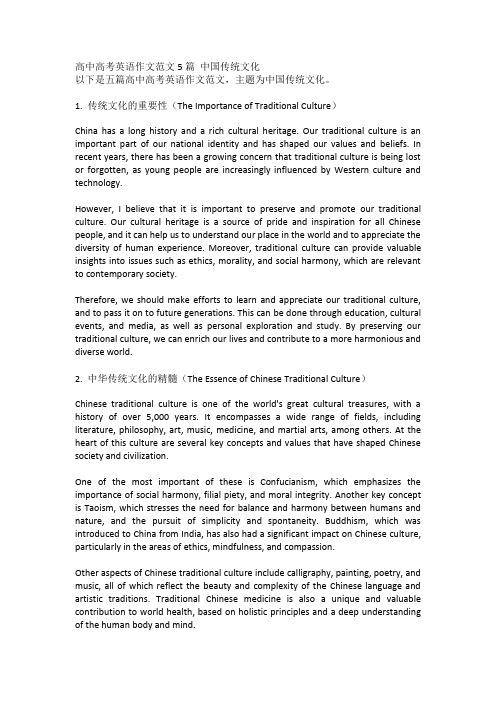
高中高考英语作文范文5篇中国传统文化以下是五篇高中高考英语作文范文,主题为中国传统文化。
1. 传统文化的重要性(The Importance of Traditional Culture)China has a long history and a rich cultural heritage. Our traditional culture is an important part of our national identity and has shaped our values and beliefs. In recent years, there has been a growing concern that traditional culture is being lost or forgotten, as young people are increasingly influenced by Western culture and technology.However, I believe that it is important to preserve and promote our traditional culture. Our cultural heritage is a source of pride and inspiration for all Chinese people, and it can help us to understand our place in the world and to appreciate the diversity of human experience. Moreover, traditional culture can provide valuable insights into issues such as ethics, morality, and social harmony, which are relevant to contemporary society.Therefore, we should make efforts to learn and appreciate our traditional culture, and to pass it on to future generations. This can be done through education, cultural events, and media, as well as personal exploration and study. By preserving our traditional culture, we can enrich our lives and contribute to a more harmonious and diverse world.2. 中华传统文化的精髓(The Essence of Chinese Traditional Culture)Chinese traditional culture is one of the world's great cultural treasures, with a history of over 5,000 years. It encompasses a wide range of fields, including literature, philosophy, art, music, medicine, and martial arts, among others. At the heart of this culture are several key concepts and values that have shaped Chinese society and civilization.One of the most important of these is Confucianism, which emphasizes the importance of social harmony, filial piety, and moral integrity. Another key concept is Taoism, which stresses the need for balance and harmony between humans and nature, and the pursuit of simplicity and spontaneity. Buddhism, which was introduced to China from India, has also had a significant impact on Chinese culture, particularly in the areas of ethics, mindfulness, and compassion.Other aspects of Chinese traditional culture include calligraphy, painting, poetry, and music, all of which reflect the beauty and complexity of the Chinese language and artistic traditions. Traditional Chinese medicine is also a unique and valuable contribution to world health, based on holistic principles and a deep understanding of the human body and mind.In conclusion, the essence of Chinese traditional culture lies in its rich and diverse history, its enduring values and concepts, and its contributions to human knowledge and understanding. By studying and appreciating this culture, we can gain a deeper appreciation for the beauty and complexity of the human experience, and contribute to a more harmonious and peaceful world.3. 传统文化与现代社会(Traditional Culture and Modern Society)The rapid development of modern society has brought about many changes in the lives of people around the world. With the rise of technology, globalization, and consumerism, traditional cultures have come under threat, as people turn away from traditional values and practices in favor of new and more exciting experiences.However, I believe that traditional culture still has an important role to play in modern society. While it may not provide all the answers to the challenges we face, it can offer valuable insights and perspectives on issues such as ethics, morality, and social harmony. Moreover, traditional culture can provide a sense of continuity and identity in a rapidly changing world, helping us to understand our place in the world and to appreciate the diversity of human experience.At the same time, it is important to recognize that traditional culture is not static, but constantly evolving and adapting to new circumstances. As such, it can and should be integrated into modern society in ways that are relevant and meaningful. This might involve incorporating traditional values and practices into education, business, and governance, or creating new forms of cultural expression that draw on traditional themes and motifs.Ultimately, the relationship between traditional culture and modern society is a complex and dynamic one, and requires ongoing dialogue and engagement. By valuing and preserving our cultural heritage, while also embracing innovation and change, we can create a more vibrant and inclusive world that respects and celebrates diversity.4. 走近中国传统文化(Getting to Know Chinese Traditional Culture)China is a vast and diverse country, with a rich and varied cultural heritage. For those who are interested in exploring Chinese traditional culture, there are many fascinating and rewarding avenues to explore.One of the best ways to begin is by learning about the history and philosophy of China, which provide a broad and deep foundation for understanding Chinese culture. Key figures and concepts to explore might include Confucius, Laozi, the Tao Te Ching, the Analects, and the I Ching, among others.Another important aspect of Chinese traditional culture is the arts, including calligraphy, painting, poetry, and music. These art forms reflect the beauty and complexity of the Chinese language and artistic traditions, and can provide insights into the values and beliefs of Chinese society.Traditional Chinese medicine is also a unique and valuable contribution to world health, based on holistic principles and a deep understanding of the human body and mind. By exploring this field, one can gain a deeper appreciation for the interconnectedness of all aspects of life and health.Finally, it is important to experience Chinese culture firsthand, through travel, cuisine, and social interactions. By immersing oneself in Chinese culture, one can gain a deeper understanding and appreciation for its many facets, and develop a greater sense of connection and empathy with the Chinese people.In conclusion, getting to know Chinese traditional culture is a rewarding and enriching experience, one that can broaden our horizons and deepen our understanding of the world around us. By exploring this rich and diverse cultural heritage, we can gain new perspectives on our own lives and values, and contribute to a more harmonious and inclusive world.5. 传统文化的创新与发展(Innovation and Development in Traditional Culture)While traditional culture is often seen as something static and unchanging, it is in fact a dynamic and evolving phenomenon that is constantly being renewed and reinterpreted by new generations. In this sense, innovation and development are essential aspects of traditional culture, as they allow it to remain relevant and meaningful in changing times.One example of this is the development of Chinese martial arts, which has a long and rich history dating back to ancient times. Today, martial arts are practiced by millions of people around the world, and have evolved into a diverse and vibrant art form that reflects the values and aspirations of modern society.Another example is the development of Chinese cuisine, which has a rich and varied history that spans thousands of years. Today, Chinese cuisine is enjoyed by people around the world, and has been adapted and modified to suit the tastes and preferences of different cultures and regions.Similarly, traditional Chinese medicine has been adapted and developed over time to incorporate new scientific knowledge and approaches, while still retaining its holistic and integrated principles.In conclusion, innovation and development are essential aspects of traditional culture, as they allow it to remain relevant and meaningful in changing times. By embracing new ideas and approaches while still honoring our cultural heritage, we can create a more vibrant and inclusive world that respects and celebrates diversity.。
高中英语 高考英语作文有关中国传统文化的范文5篇带中文翻译

高中英语高考英语作文有关中国传统文化的范文5篇带中文翻译范文1:传统建筑Traditional Chinese architecture has a long history and outstanding artistic value. It reflects the cultural inheritance and spiritual characteristics of the Chinese nation, and is also an important component of the treasure trove of Chinese art.The characteristics of traditional architecture are emphasizing harmony, respecting nature, emphasizing meteorology, and reflecting national culture. Typical traditional buildings include various bridges on the Beijing Hangzhou Grand Canal, temples, gardens and different kinds of folk houses with different styles on both sides of the river. For example, the roof tiles, eaves, arch of wooden architecture and sculptures of ancient buildings have superb skills and exquisite aesthetic values. In traditional architecture, it also reflects the development of politics, economy, and culture. Nowadays, traditional architecture has not only become an important part of China's cultural soft power, but also an important role in Sino foreign exchanges, Chinese cities, and the tourism market. The value and significance of traditional architecture are receiving increasing attention and recognition.中国传统建筑,有着悠久的历史和卓越的艺术价值。
高中高考英语作文范文5篇 中国传统文化
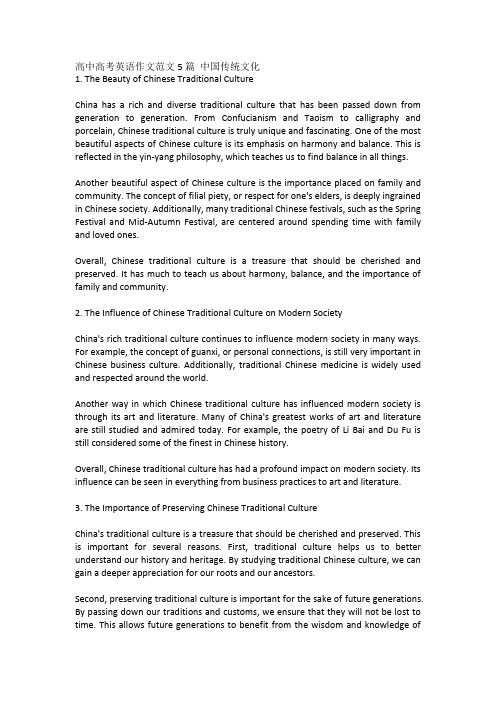
高中高考英语作文范文5篇中国传统文化1. The Beauty of Chinese Traditional CultureChina has a rich and diverse traditional culture that has been passed down from generation to generation. From Confucianism and Taoism to calligraphy and porcelain, Chinese traditional culture is truly unique and fascinating. One of the most beautiful aspects of Chinese culture is its emphasis on harmony and balance. This is reflected in the yin-yang philosophy, which teaches us to find balance in all things.Another beautiful aspect of Chinese culture is the importance placed on family and community. The concept of filial piety, or respect for one's elders, is deeply ingrained in Chinese society. Additionally, many traditional Chinese festivals, such as the Spring Festival and Mid-Autumn Festival, are centered around spending time with family and loved ones.Overall, Chinese traditional culture is a treasure that should be cherished and preserved. It has much to teach us about harmony, balance, and the importance of family and community.2. The Influence of Chinese Traditional Culture on Modern SocietyChina's rich traditional culture continues to influence modern society in many ways. For example, the concept of guanxi, or personal connections, is still very important in Chinese business culture. Additionally, traditional Chinese medicine is widely used and respected around the world.Another way in which Chinese traditional culture has influenced modern society is through its art and literature. Many of China's greatest works of art and literature are still studied and admired today. For example, the poetry of Li Bai and Du Fu is still considered some of the finest in Chinese history.Overall, Chinese traditional culture has had a profound impact on modern society. Its influence can be seen in everything from business practices to art and literature.3. The Importance of Preserving Chinese Traditional CultureChina's traditional culture is a treasure that should be cherished and preserved. This is important for several reasons. First, traditional culture helps us to better understand our history and heritage. By studying traditional Chinese culture, we can gain a deeper appreciation for our roots and our ancestors.Second, preserving traditional culture is important for the sake of future generations. By passing down our traditions and customs, we ensure that they will not be lost to time. This allows future generations to benefit from the wisdom and knowledge ofour ancestors.Finally, preserving traditional culture is important for the sake of cultural diversity. In a world that is becoming increasingly homogenized, it is important to celebrate and preserve the unique cultural traditions that make us who we are.Overall, the importance of preserving Chinese traditional culture cannot be overstated. It is a vital part of our history, our heritage, and our identity as a people.4. The Role of Confucianism in Chinese Traditional CultureConfucianism is one of the most important aspects of Chinese traditional culture. This philosophy, which is based on the teachings of the philosopher Confucius, emphasizes the importance of moral values such as respect, loyalty, and benevolence.Confucianism has had a profound impact on Chinese culture. It has influenced everything from government and education to social relationships and family values. For example, the concept of filial piety, or respect for one's elders, is deeply ingrained in Chinese society and is a direct result of Confucian teachings.Overall, Confucianism is a vital part of Chinese traditional culture. Its emphasis on moral values has helped to shape Chinese society and has had a profound impact on the country's history and culture.5. The Significance of Chinese Calligraphy in Traditional CultureChinese calligraphy is a unique and beautiful art form that has been an important part of Chinese traditional culture for thousands of years. It is considered one of the highest forms of art in China and is admired around the world for its beauty and complexity.Chinese calligraphy is more than just an art form, however. It is also a form of meditation and a way of connecting with the spiritual world. Calligraphers often spend years studying the art form and developing their skills, which requires patience, discipline, and a deep understanding of Chinese culture and history. Overall, Chinese calligraphy is a vital part of traditional Chinese culture. Its beauty and complexity reflect the wisdom and depth of Chinese culture, and its significance as a form of meditation speaks to the spiritual nature of the art form.。
高考英语作文 范文4篇 中国传统文化

高考英语作文范文4篇中国传统文化中国传统文化是我们国家的瑰宝,它凝聚了我们民族的智慧和精神。
以下是四篇关于中国传统文化的高考英语范文:范文一:传统节日Chinese traditional festivals play a vital role in our culture. The Spring Festival, for example, is the most important one which marks the beginning of the lunar New Year. During the festival, people exchange gifts, set off fireworks, and have family reunion dinners. These customs not only bring joy and happiness but also strengthen family bonds. Another traditional festival worth mentioning is the Mid-Autumn Festival, also known as the Moon Festival. On this day, people appreciate the full moon, eat mooncakes, and share stories with their families. These festivals not only preserve our traditions but also provide an opportunity for family members to gather and express their love and care for each other.范文二:传统艺术Traditional Chinese art forms, such as calligraphy, painting, and opera, have a profound influence on our culture. Calligraphy is considered the essence of Chinese culture, embodying both beauty and wisdom. Chinese painting, with its unique brushwork and natural themes, reflects the harmony between man and nature. Traditional Chinese opera, with its colorful costumes and unique singing styles, tells stories and conveys emotions in a distinctive way. These art forms not only entertain people but also convey our cultural heritage and values.范文三:传统文化与现代社会In today's modern society, traditional Chinese culture still holds great significance. Traditional values such as filial piety, respect for elders, and the importance of education are deeply rooted in our society. These values guide our behavior and shape our character. Additionally, traditional Chinese medicine, with its holistic approach to health, continues to gain popularity not only in China but also around the world. Furthermore, traditional Chinese architecture, with its unique features and principles, is not only a symbol of our cultural identity but also a source of inspiration for modern architects. In summary, traditional Chinese culture continues to play a crucial role in shaping our society and enriching our lives.范文四:传统文化的传承和保护The inheritance and protection of traditional Chinese culture are of great importance. To begin with, it is crucial to promote traditional cultural education in schools and universities. This includes incorporating traditional cultural elements into the curriculum and organizing cultural activities and events. Furthermore, it is importantto support and encourage traditional artists and craftsmen, providing them with opportunities to showcase their skills and pass on their knowledge to future generations. Additionally, the government should implement policies to protect and preserve cultural heritage sites, artifacts, and intangible cultural heritage. Finally, promoting cultural exchange and communication with other countries can help to enhance the international recognition and appreciation of Chinese traditional culture. By taking these measures, we can ensure the preservation and continuation of our rich cultural heritage.。
高中高考英语作文范文5篇 中国传统文化
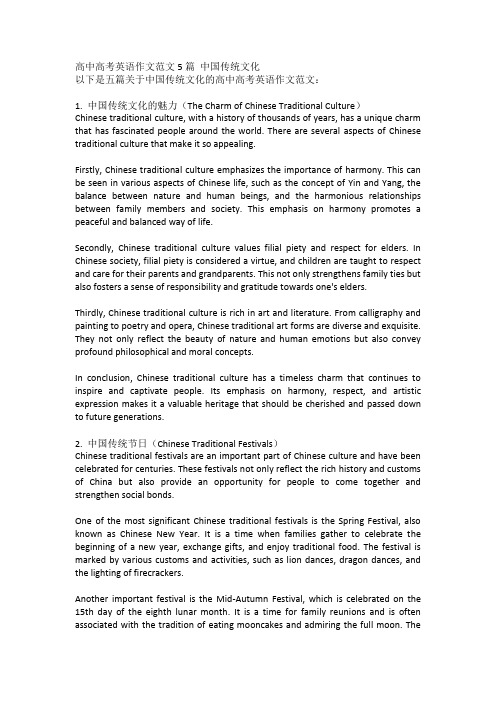
高中高考英语作文范文5篇中国传统文化以下是五篇关于中国传统文化的高中高考英语作文范文:1. 中国传统文化的魅力(The Charm of Chinese Traditional Culture)Chinese traditional culture, with a history of thousands of years, has a unique charm that has fascinated people around the world. There are several aspects of Chinese traditional culture that make it so appealing.Firstly, Chinese traditional culture emphasizes the importance of harmony. This can be seen in various aspects of Chinese life, such as the concept of Yin and Yang, the balance between nature and human beings, and the harmonious relationships between family members and society. This emphasis on harmony promotes a peaceful and balanced way of life.Secondly, Chinese traditional culture values filial piety and respect for elders. In Chinese society, filial piety is considered a virtue, and children are taught to respect and care for their parents and grandparents. This not only strengthens family ties but also fosters a sense of responsibility and gratitude towards one's elders.Thirdly, Chinese traditional culture is rich in art and literature. From calligraphy and painting to poetry and opera, Chinese traditional art forms are diverse and exquisite. They not only reflect the beauty of nature and human emotions but also convey profound philosophical and moral concepts.In conclusion, Chinese traditional culture has a timeless charm that continues to inspire and captivate people. Its emphasis on harmony, respect, and artistic expression makes it a valuable heritage that should be cherished and passed down to future generations.2. 中国传统节日(Chinese Traditional Festivals)Chinese traditional festivals are an important part of Chinese culture and have been celebrated for centuries. These festivals not only reflect the rich history and customs of China but also provide an opportunity for people to come together and strengthen social bonds.One of the most significant Chinese traditional festivals is the Spring Festival, also known as Chinese New Year. It is a time when families gather to celebrate the beginning of a new year, exchange gifts, and enjoy traditional food. The festival is marked by various customs and activities, such as lion dances, dragon dances, and the lighting of firecrackers.Another important festival is the Mid-Autumn Festival, which is celebrated on the 15th day of the eighth lunar month. It is a time for family reunions and is often associated with the tradition of eating mooncakes and admiring the full moon. Thefestival is also known for its beautiful lantern displays and the practice of writing wishes on lanterns and releasing them into the sky.Other notable Chinese traditional festivals include the Dragon Boat Festival, the Lantern Festival, and the Qingming Festival. Each of these festivals has its own unique customs and traditions, but they all share the common goal of fostering unity, promoting cultural heritage, and bringing joy to people's lives.In conclusion, Chinese traditional festivals play a vital role in preserving and promoting Chinese culture. They provide a platform for people to connect with their roots, strengthen family ties, and pass down customs and traditions from generation to generation.3. 中国传统文化与现代社会(Chinese Traditional Culture and Modern Society)Chinese traditional culture, with its long history and profound influence, continues to play a significant role in modern society. Despite the rapid changes brought about by globalization and modernization, Chinese traditional culture remains a source of inspiration and guidance for many people.One aspect of Chinese traditional culture that is particularly relevant to modern society is the concept of Confucianism. Confucianism emphasizes the importance of moral values, social harmony, and the cultivation of personal character. These principles are still highly regarded in Chinese society today, and many people turn to Confucian teachings for guidance in their personal and professional lives.In addition, Chinese traditional culture places great importance on the preservation of family values and filial piety. In an era of rapid social change and individualism, these values provide a solid foundation for building strong family relationships and promoting social stability. Many people still adhere to the traditional values of respecting their elders and taking care of their families.Furthermore, Chinese traditional culture has a rich heritage of art, literature, and philosophy. Traditional art forms such as calligraphy, painting, and opera continue to be appreciated and practiced by many. Traditional philosophical concepts, such as the Daoist idea of living in harmony with nature, also resonate with people in today's fast-paced and stressful world.In conclusion, Chinese traditional culture continues to be relevant and influential in modern society. Its emphasis on moral values, family relationships, and artistic expression provides valuable guidance and inspiration for individuals seeking meaning and balance in their lives.4. 中国传统美食(Chinese Traditional Cuisine)Chinese traditional cuisine, known for its diversity, flavors, and health benefits, is anintegral part of Chinese culture. It reflects the country's rich culinary heritage and regional specialties.One of the most famous Chinese traditional dishes is Peking Roast Duck, which originated in Beijing. It is characterized by its crispy skin, tender meat, and aromatic flavors. The dish is often served with thin pancakes, scallions, and sweet bean sauce, creating a delicious combination of textures and tastes.Another iconic Chinese dish is Kung Pao Chicken, which hails from Sichuan province. It is a spicy stir-fry dish that combines chicken, peanuts, vegetables, and chili peppers. The dish is known for its bold flavors and fiery taste, which is characteristic of Sichuan cuisine.In addition to these well-known dishes, Chinese traditional cuisine is also famous for its dim sum, hot pot, dumplings, and various regional specialties. Each region in China has its own unique culinary traditions and flavors, resulting in a diverse and vibrant food culture.Chinese traditional cuisine not only satisfies the taste buds but also promotes health and well-being. Traditional Chinese medicine principles, such as the balance of Yin and Yang and the use of natural ingredients, are often incorporated into cooking. Many traditional Chinese ingredients, such as ginger, garlic, and green tea, are believed to have medicinal properties and are used for their health benefits.In conclusion, Chinese traditional cuisine is a treasure trove of flavors, textures, and cultural heritage. It is not only a delicious and satisfying culinary experience but alsoa reflection of China's rich history and diverse regional cultures.5. 中国传统服饰(Chinese Traditional Clothing)Chinese traditional clothing, known as Hanfu, has a long history and represents the rich cultural heritage of China. It is characterized by its elegant designs, intricate details, and symbolic meanings.Hanfu, which literally means "Han clothing," refers to the traditional attire worn by the Han ethnic group in ancient China. It consists of several components, including the Zhongshan suit, the Changshan suit, and the Qipao. Each style has its own unique features and is associated with different periods in Chinese history.The Zhongshan suit, also known as the Mao suit, was popularized by Dr. Sun Yat-sen, the founding father of modern China. It is a formal suit consisting of a jacket and trousers, often worn with a Mandarin collar and a buttoned-up front. The Zhongshan suit represents the spirit of nationalism and revolution in early 20th-century China. The Changshan suit, also known as the "long gown," is a traditional Chinese robethat dates back to the Ming Dynasty. It is characterized by its loose fit, high collar, and flowing sleeves. The Changshan suit is often worn on formal occasions, such as weddings and festive celebrations.The Qipao, also known as the Cheongsam, is a form-fitting dress that became popular in the 1920s. It is characterized by its high collar, form-fitting silhouette, and side slits. The Qipao is often associated with elegance, femininity, and modernity.In recent years, there has been a revival of interest in Hanfu, with more people embracing it as a form of cultural expression and identity. Hanfu enthusiasts can often be seen wearing traditional clothing at cultural events, weddings, and other special occasions.In conclusion, Chinese traditional clothing is a reflection of China's rich history and cultural diversity. It not only represents the aesthetic values of ancient China but also serves as a symbol of national identity and pride.。
高考英语作文 范文5篇 中国传统文化

高考英语作文范文5篇中国传统文化1. 中华传统节日-春节(Chinese Traditional Festival - Spring Festival)Spring Festival, also known as Chinese New Year, is the most important traditional festival in China. It marks the beginning of the lunar calendar and is a time for family reunion and celebration. During the Spring Festival, people decorate their homes with red lanterns and couplets, and they gather for a big feast on New Year's Eve. The festival is also famous for the lion and dragon dances, firework displays, and the giving of lucky money to children. The Spring Festival is not only a time for celebration, but also a time to honor ancestors and carry forward Chinese traditional values.2. 传统中医文化(Traditional Chinese Medicine Culture)Traditional Chinese medicine (TCM) is a unique medical system that has been practiced for thousands of years in China. It is based on the concept of balance and harmony in the body, and it includes various treatment methods such as acupuncture, herbal medicine, and massage. TCM emphasizes the prevention of diseases rather than just treating symptoms, and it takes into account the individual's physical and mental well-being. TCM has gained recognition worldwide for its effectiveness in treating various ailments and promoting overall health. It is not only a medical system, but also a part of Chinese culture that reflects the wisdom and philosophy of the Chinese people.3. 中国传统艺术-京剧(Chinese Traditional Art - Peking Opera)Peking Opera, also known as Beijing Opera, is a traditional Chinese art form that combines singing, dancing, acting, and acrobatics. It originated in the late 18th century and has become one of the most famous forms of Chinese opera. Peking Opera is known for its elaborate costumes, colorful makeup, and unique vocal techniques. It tells stories from Chinese history, folklore, and literature, and it often conveys moral values and traditional virtues. Peking Opera is not only a form of entertainment, but also a reflection of Chinese history, culture, and aesthetics.4. 传统中国茶文化(Traditional Chinese Tea Culture)Tea has a long history in China and is deeply rooted in Chinese culture. Chinese tea culture emphasizes the art of tea preparation, appreciation, and the social interactions that take place during tea ceremonies. There are various types of Chinese tea, each with its own unique flavor and health benefits. Tea is not only a beverage, but also a symbol of hospitality, friendship, and peace. The tea ceremony is a way for people to connect with nature, calm their minds, and appreciate the beauty of life. Chinese tea culture has influenced many other countries and has become a popular trend worldwide.5. 中国传统建筑-古代园林(Chinese Traditional Architecture - Ancient Gardens) Ancient Chinese gardens are known for their exquisite design, harmonious layout,and integration of nature and architecture. These gardens were created as private retreats for scholars, nobles, and emperors to escape from the busy city life and connect with nature. The design of Chinese gardens often includes elements such as pavilions, bridges, ponds, rockeries, and plants that symbolize different meanings. The beauty of Chinese gardens lies in their ability to create a tranquil and peaceful environment that reflects the harmony between man and nature. Ancient gardens are not only a display of architectural skills, but also a manifestation of Chinese philosophy and aesthetics.。
高中英语 高考英语作文有关中国传统文化的范文5篇带中文翻译

高中英语高考英语作文有关中国传统文化的范文5篇带中文翻译范文一:中国传统节日Chinese traditional festivals play an important role in Chinese culture. Among them, the Spring Festival is the most significant one. It is a time for family reunion, when people gather together, have festive meals, and exchange blessings. The Dragon Boat Festival and Mid-Autumn Festival are also celebrated widely. These festivals not only offer people a chance to relax and enjoy themselves, but also promote traditional values and customs, such as filial piety and respect for ancestors. Through these festivals, we can learn more about Chinese history, traditions, and customs, and pass them on to future generations.范文二:中国传统艺术Chinese traditional art, with a history of thousands of years, is a treasure of Chinese culture. Calligraphy, for example, is considered as the essence of Chinese culture. It not only requires skillful brushwork, but also embodies the beauty of Chinese characters. Chinese paintings, known for their unique painting techniques and rich cultural connotations, are admired by people all over the world. In addition, traditional Chinese music, opera, and dance are also highly appreciated for their elegance and grace. These art forms not only reflect the aesthetics of Chinese people, but also convey profound cultural meanings.范文三:中国传统美食Chinese traditional cuisine is renowned worldwide for its diversity and flavors. From the spicy Sichuan cuisine to the delicate Cantonese cuisine, each region has its own specialty dishes. For example, Peking duck, known for its crispy skin and tender meat, is a must-try when visiting Beijing. Dim sum, a variety of bite-sized dishes, is a popular choice for breakfast or afternoon tea in southern China. Chinese cuisine not only satisfies people's taste buds, but also reflects the philosophy of balance and harmony in Chinese culture. The art of Chinese cooking has been passed down from generation to generation, and it continues to evolve and innovate while preserving its traditional roots.范文四:中国传统服饰Traditional Chinese clothing, known as Hanfu, has a long history and unique charm. It is characterized by its loose, flowing silhouette and exquisite craftsmanship. Hanfu consists of various garments, such as the Ruqun for women and the Zhongshan suit for men. Each garment has its own distinctive style and symbolic meaning. Traditional Chinese clothing not only reflects the aesthetic taste of different dynasties, but also represents the etiquette and social status of the wearers. Nowadays, Hanfu is experiencing a revival, and more and more people are embracing it as a way to showcase their cultural identity and appreciation for Chinese traditions.范文五:中国传统建筑Chinese traditional architecture, with its distinctive style and profound cultural connotations, is a true representation of Chinese culture. The Forbidden City in Beijing, with its grandeur and meticulous design, is a masterpiece of traditional Chinese architecture. The classical gardens in Suzhou, known for their harmonious layout and exquisite details, showcase the perfect integration of nature and human creations. Traditional Chinese architecture also emphasizes the balance of Yin and Yang, and the harmony between man and nature. It is not only a manifestation of architectural skills, but also a reflection of the wisdom and philosophy of the Chinese people.范文一:中国传统节日中国传统节日在中国文化中占有重要地位。
高考英语作文 范文5篇 中国传统文化
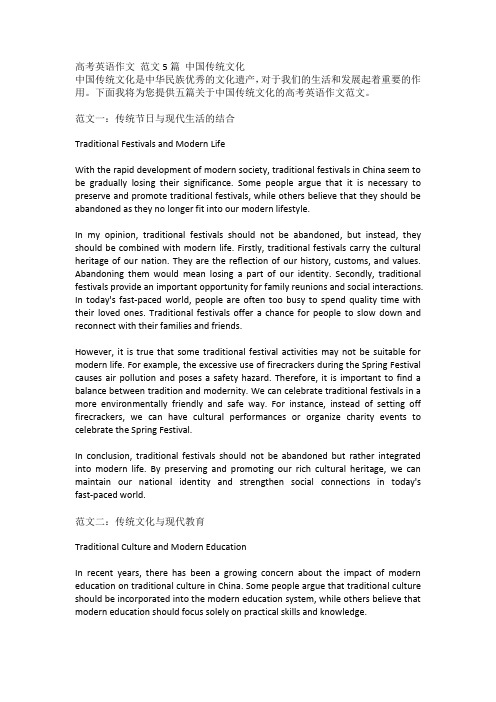
高考英语作文范文5篇中国传统文化中国传统文化是中华民族优秀的文化遗产,对于我们的生活和发展起着重要的作用。
下面我将为您提供五篇关于中国传统文化的高考英语作文范文。
范文一:传统节日与现代生活的结合Traditional Festivals and Modern LifeWith the rapid development of modern society, traditional festivals in China seem to be gradually losing their significance. Some people argue that it is necessary to preserve and promote traditional festivals, while others believe that they should be abandoned as they no longer fit into our modern lifestyle.In my opinion, traditional festivals should not be abandoned, but instead, they should be combined with modern life. Firstly, traditional festivals carry the cultural heritage of our nation. They are the reflection of our history, customs, and values. Abandoning them would mean losing a part of our identity. Secondly, traditional festivals provide an important opportunity for family reunions and social interactions. In today's fast-paced world, people are often too busy to spend quality time with their loved ones. Traditional festivals offer a chance for people to slow down and reconnect with their families and friends.However, it is true that some traditional festival activities may not be suitable for modern life. For example, the excessive use of firecrackers during the Spring Festival causes air pollution and poses a safety hazard. Therefore, it is important to find a balance between tradition and modernity. We can celebrate traditional festivals in a more environmentally friendly and safe way. For instance, instead of setting off firecrackers, we can have cultural performances or organize charity events to celebrate the Spring Festival.In conclusion, traditional festivals should not be abandoned but rather integrated into modern life. By preserving and promoting our rich cultural heritage, we can maintain our national identity and strengthen social connections in today's fast-paced world.范文二:传统文化与现代教育Traditional Culture and Modern EducationIn recent years, there has been a growing concern about the impact of modern education on traditional culture in China. Some people argue that traditional culture should be incorporated into the modern education system, while others believe that modern education should focus solely on practical skills and knowledge.In my opinion, traditional culture should be an integral part of modern education. Firstly, traditional culture embodies the wisdom and values of our ancestors. It provides us with a profound understanding of our history, customs, and moral principles. By learning traditional culture, students can develop a sense of identity and pride in their cultural heritage. Secondly, traditional culture fosters important qualities such as respect, diligence, and humility. These qualities are essential for personal growth and social harmony. By integrating traditional culture into education, we can cultivate well-rounded individuals who are not only knowledgeable but also morally upright.However, it is important to strike a balance between traditional culture and practical skills. In today's highly competitive world, students need to acquire practical knowledge and skills that can help them succeed in their future careers. Therefore, modern education should also emphasize the development of critical thinking, problem-solving, and communication skills.In conclusion, traditional culture should be incorporated into the modern education system. By doing so, we can preserve our cultural heritage, cultivate moral values, and equip students with the necessary skills for their future success.范文三:传统艺术的保护与传承Preservation and Inheritance of Traditional ArtsTraditional arts, such as calligraphy, painting, and opera, are an important part of Chinese culture. However, in today's rapidly changing society, traditional arts face the risk of being neglected and forgotten. Therefore, it is crucial to protect and inherit our traditional arts.Firstly, traditional arts carry the essence of our cultural heritage. They reflect the wisdom, aesthetics, and values of our ancestors. By preserving traditional arts, we can pass on our cultural traditions to future generations and maintain our national identity. Secondly, traditional arts have educational value. They cultivate important qualities such as patience, discipline, and creativity. By learning traditional arts, individuals can develop a sense of appreciation for beauty and a deeper understanding of our cultural heritage.To protect and inherit traditional arts, several measures can be taken. Firstly, the government should provide financial support and favorable policies for the preservation and promotion of traditional arts. This can include funding for art organizations, subsidies for artists, and the establishment of cultural heritage protection zones. Secondly, educational institutions should incorporate traditional arts into their curriculum. By introducing traditional arts to students at a young age, we can cultivate their interest and appreciation for these art forms. Finally, culturalexchange programs and international exhibitions can help promote traditional arts on a global scale.In conclusion, the preservation and inheritance of traditional arts are of great importance. By protecting and promoting traditional arts, we can preserve our cultural heritage, cultivate important qualities, and promote cultural exchange.范文四:传统文化与旅游业的发展Traditional Culture and the Development of TourismIn recent years, tourism has become a major industry in China. More and more people are traveling to experience different cultures and traditions. The development of tourism provides an opportunity to promote and preserve our traditional culture.Firstly, traditional culture is the soul of tourism. It is the unique cultural heritage that attracts tourists from all around the world. Traditional architecture, festivals, and customs are all part of our cultural identity. By promoting traditional culture, we can attract more tourists and boost the tourism industry. Secondly, the development of tourism can help preserve traditional culture. As more tourists visit cultural heritage sites, there is a greater awareness of the need to protect and maintain these sites. This can lead to the preservation of historical buildings, artifacts, and traditional practices.However, it is important to strike a balance between tourism development and the protection of traditional culture. Over-commercialization and excessive tourism can lead to the loss of authenticity and the commodification of culture. Therefore, it is crucial to implement sustainable tourism practices that respect local traditions and minimize negative impacts on the environment and local communities.In conclusion, the development of tourism provides an opportunity to promote and preserve our traditional culture. By striking a balance between tourism development and cultural preservation, we can attract more tourists, boost the tourism industry, and maintain our cultural heritage.范文五:传统文化与现代科技的融合Integration of Traditional Culture and Modern TechnologyIn today's digital age, traditional culture and modern technology seem to be at odds with each other. However, I believe that the integration of traditional culture and modern technology can bring about new opportunities and enrich our lives.Firstly, modern technology can help preserve and promote traditional culture. Digital platforms and social media provide a convenient and effective way to share traditional art forms, such as music, dance, and crafts. Through online platforms, traditional artists can reach a wider audience and gain recognition for their work. Secondly, modern technology can enhance our understanding and appreciation of traditional culture. Virtual reality and augmented reality technologies can recreate historical scenes, allowing people to immerse themselves in the rich cultural heritage of our nation. This not only makes learning more interactive and engaging but also helps to preserve historical sites and artifacts.On the other hand, traditional culture can also inspire and guide the development of modern technology. Traditional wisdom and values can provide a moral compass for the ethical use of technology. For example, the concept of harmony and balance from traditional Chinese philosophy can be applied to the development of sustainable and environmentally friendly technologies. Furthermore, traditional craftsmanship can inspire innovation in design and manufacturing processes.In conclusion, the integration of traditional culture and modern technology can bring about new opportunities and enrich our lives. By leveraging the strengths of both, we can promote and preserve our cultural heritage while embracing the benefits of modern technology.。
- 1、下载文档前请自行甄别文档内容的完整性,平台不提供额外的编辑、内容补充、找答案等附加服务。
- 2、"仅部分预览"的文档,不可在线预览部分如存在完整性等问题,可反馈申请退款(可完整预览的文档不适用该条件!)。
- 3、如文档侵犯您的权益,请联系客服反馈,我们会尽快为您处理(人工客服工作时间:9:00-18:30)。
高考英语传统文化素材作文总结
高考英语传统文化作文素材: 长城
长城(The Great Wall)
The Great Wall is one of the wonders of the world
that created by human beings! If you e to China without climbing the Great Wall, its just like going Paris without visiting the Eiffel Tower; or going to Egypt without visiting the Pyramids! Men often say, He who doest not reach the Great Wall is not a true man.In fact, it began as independent walls for different states when
it was first built, and did not bee the Great Wall until the Qin Dynasty. However, the wall we see today, starting from Shanhaiguan Pass in the east to Jiayunguan Pass in the west, was mostly built during the Ming Dynasty.
长城是人类创造的世界奇迹之一。
如果你到了中国却没去过长城就像到了巴黎没有去看看菲尔铁塔或者就像到了埃及没有去看金字塔一样。
人们常说:不到长城非好汉。
实际上长城最初只是一些断断续续的城墙直到秦朝统一中国后才将其连城长城。
然而今天我们看到的长城东起山海关西至嘉峪关大部分都是在明代修建的。
高考英语传统文化作文素材: 天干地支
天干地支(Chinese Era)
The Chinese era is the symbol that the Chinese calendar uses for recording and naming years. The ten Heavenly Stems are: jia, yi, bing, ding, wu, ji, geng,
_in, ren, gui. The twelve Earthly Branches are: zi.chou, yin, mou, chen, si, wu, wei, shen, you, _u, hai. After observing the lunar month, the ancients found that the moon always wazes and wanes roughly 12 times a year, and two lunar months account for about 60 days, so the order of the ten Heavenly Stems and the order of the twelve Earthly Branches are properly matched in turn. In terms of recording date, 60 years is considered to be a full time cycle. The Chinese era chronology was first invented in ancient times and is still in use now.
天干地支是中国历法中用以记录和命名年岁的方法。
十天干为:甲、乙、丙、丁、戊、已、庚、辛、壬、癸;十二地支为:子、丑、寅、卯、辰、巳、午、未、申、酉、戊、亥。
古人观测朔望月发现月亮圆缺12次大体上是一年的天数而两个朔望月约是60天。
古人以十天干与十二地支的顺序依次相配记录不同年份60年为一个轮回。
干支纪年法从古沿用至今。
高考英语传统文化作文素材: 文房四宝
文房四宝(The Four Treasures of the Study)
The writing brush, ink stick, ink stone, and paper were requisite treasures in the study of the scholars of ancient China, and they are often referred to as the Four Treasures of the Study. The writing brush and ink stick have been used by the Chinese to write and paint since 5,000 years ago. In the Qin Dynasty (221BC---206BC), people already used feathers of different hardness and bamboo trunks to make brushes. During the Han Dynasty (206BC-220AD), man-made ink was used instead of natural ink. After paper was invented by the Chinese, bamboo slips, wooden tablets, brocade and silk, which originally functioned as writing surfaces, gradually faded out. The ink stone was first developed with the use of writing brushes and ink. After the Song Dynasty (960AD---1279AD), the Four Treasure of the Study particularly referred to hubi, the writing brush produced in Huzhou, Zhejiang province; huimo, the ink stick produced in Huizhou, Anhui province; _uan paper, a kind of paper produced in
_uanzhou, Anhui province; and duanyan, the ink stone made in Zhaoqing, Guangdong province (Zhaoqing was earlier called Duanzhou). Indeed, the Four Treasures of the Study have writtin the whole Chinese civilization, as it is.
笔墨纸砚是中国古代文人书房当中必备的宝贝被称为文房四宝。
用笔墨书写绘画在中国可追溯到五千年前。
秦时已用不同硬度的毛和竹管制笔;汉代以人工制墨替代了天然墨;有了纸张以后简牍锦帛逐失其用;砚台则随笔墨的使用而发展。
文房四宝到宋朝以后特指湖笔、徽墨、宣纸、端砚。
可以说文房四宝书写了整个中华文明。
